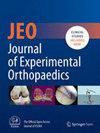Functional outcome improvement and surgical time reduction in a single-surgeon consecutive case series of hip arthroscopy for femoroacetabular impingement: A minimum 5 years follow-up study
Abstract
Purpose
The learning curve of a single surgeon performing hip arthroscopy is reported to be steep, but, to date, the inflection point after which procedures are more successful is still unknown. The aim of this study was to design a learning curve focused on clinical outcomes, complications and revision/conversion rates.
Methods
Seventy-one hip arthroscopies performed for femoroacetabular impingement (FAI) by a single surgeon, with a minimum follow-up of 5 years, were considered. Demographics, intraarticular findings and operative and traction time were detailed. HOOS score, subjective outcomes, 30-day complication rates, complication rates, revision arthroscopies and conversions to hip arthroplasty were recorded.
Results
The mean follow-up was 7.5 ± 1.8 years (range: 5–11). The progression of the learning curve implied a reduction in surgical time (r: −0.847), traction time (r: −0.806) and postoperative outcomes (r = 0.444). When the procedures were divided into three consecutive groups (25 vs. 25 vs. 21 procedures) or two consecutive groups (36 vs. 35 cases), the first group had a higher occurrence of 30-day complications (p = 0.002 and p = 0.025, respectively) and the last group experienced a significant amelioration in terms of HOOS score between the preoperative and the postoperative condition (p < 0.001 and p = 0.018).
Conclusions
The inflection point of the hip arthroscopy learning curve is between 25/36 procedures. The first arthroscopies were impacted by higher complications and lower clinical results but no higher rates of revision and conversion to arthroplasty.
Level of Evidence
Level IV.


 求助内容:
求助内容: 应助结果提醒方式:
应助结果提醒方式:


